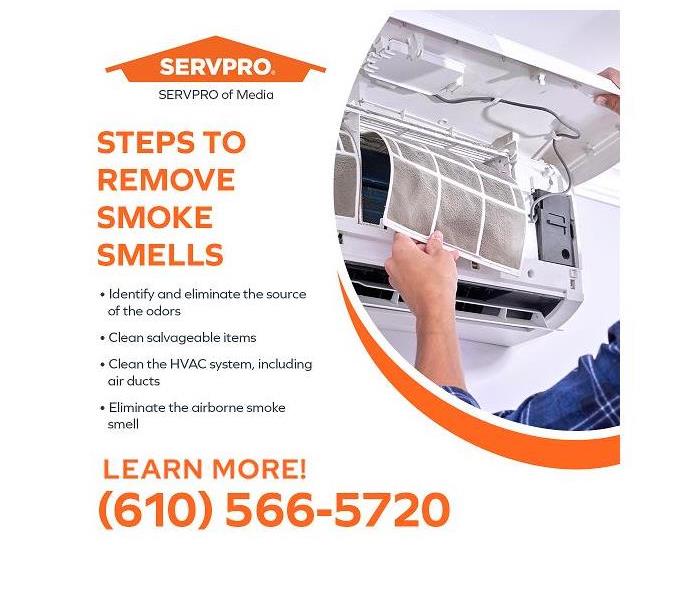Why Odor Removal Is a Key Part of the Fire Damage Restoration Process
4/22/2022 (Permalink)
Blog Summary: SERVPRO of Media highlights the odor removal process, an essential part of a fire damage remediation project.
The professionals at SERVPRO of Media are skilled at tackling the many challenges of fire and water damage restoration. A fire destroys personal belongings and causes structural damage to a home or business. The damage restoration company is tasked with cleaning up not only damage directly related to the flames but also damage resulting from extinguishing the flames. The water and chemicals used to put out the fire must be cleaned up, and smoke and soot residue must be removed. Once all the water is evacuated, the contents have been cleaned, and the structure has been repaired, restoration specialists must remove the smoke odor. Even if the residence is physically restored to its pre-disaster condition, the lingering smell of smoke is a very strong indicator that the fire damage cleanup and restoration project is incomplete. The structure that has been damaged by fire must not only look great, but it must also smell smoke-free. Odor removal is an essential service that caps off a fire damage restoration project.
One of the greatest challenges facing a fire damage restoration professional is the removal of the smoke odor. The success of this crucial phase of the restoration process involves the utilization of specialized equipment and advanced cleaning techniques and products that only a property damage restoration professional can provide. Technicians should be IICRC-certified and must be knowledgeable, experienced, and skilled to operate the equipment in a safe and effective manner. They must also be aware of the hazards of working in an environment that has sustained fire and smoke damage and take the necessary precautions, including wearing the appropriate personal protective gear (PPG). A DIY fire damage cleanup and restoration project is not advisable for the untrained, ill-equipped, and inexperienced. The risk hazards and complexity of the cleanup and restoration are too great.
The Sources of Smoke Odors
Incomplete combustion produces lots of smoke. The smoke is rich in toxic gases, soot (particles), and oils. The combination of volatile molecules from these particles, oils, and gases released during combustion produces a noxious smoke odor.
Smoke odor is so pungent because of the diverse materials in a typical home, such as the following:
- Protein: hair, wool, meat, leather
- Cellulose: Wood, cotton, hemp, plants
- Synthetic materials: Vinyl, plastic, nylon
- Toxic metals and chemicals: particleboard, OSB, electronics, aerosols, paints, solvents, household cleaning products
The wide variety of combustible substances calls for knowledgeable technicians who are proficient in the complex procedures required for fire damage cleanup and restoration.
Steps to Remove Smoke Smells
Step #1: Identify and eliminate the source of the odors.
Remove fire- and smoke-damaged items such as drywall, flooring, furniture, cabinets, electronics, appliances, and personal belongings, including clothing. Once removed from the fire-damaged area, the items may be restored or discarded, depending on their condition.
Step #2: Clean salvageable items.
Exterior surfaces are pressure washed, scrubbed, and disinfected. Mild soap and thorough rinsing are applied to interior walls and surfaces. Closets, drawers, and cabinets are cleaned inside and out. Furniture, fabrics, and carpet are cleaned at a remote location.
Step #3: Clean the HVAC system, including air ducts.
The HVAC system must be cleaned early in the restoration process to prevent recontamination of the site. The complex, delicate system requires professional expertise and special equipment.
Step #4: Eliminate the airborne smoke smell.
Once the sources of the odor have been identified and eliminated, the smoke-contaminated air must be completely removed from the structure. Complete smoke odor removal can be achieved using proven technologies.
- HEPA filtration removes 99.7% of the airborne particulate matter that triggers the smell of smoke. Once the air is scrubbed and the sources of smoke odor have been eliminated, other technologies and techniques can be utilized.
- Thermal fogging neutralizes smoke odors with fragrance modification technology. A thermal fogger emits a misted, petroleum-based deodorizer which permeates the entire structure. Strict application guidelines are followed to ensure everyone’s safety, and the application process requires everyone not using PPG to evacuate the building.
- Vapor modification is a method that deploys vaporized non-flammable, non-toxic, non-oily aromatic mineral oils throughout the home with fans and blowers. This technology is effective on porous materials in furniture and upholstery and is also safe for humans and pets.
- Ozone machines use ozone to neutralize stubborn protein smoke, but technicians follow safety guidelines to avoid risk hazards associated with breathing ozone.
- Hydroxyl generators destroy pathogens and eliminate VOCs (volatile organic compounds) and odors from indoor air using an advanced oxidation process.
Smoke odor removal requires knowledge, expertise, and the right tools and cleaning products. The odor removal experts at SERVPRO of Media are trained to identify and eliminate the smoke odor at its sources. Technicians receive IICRC training in odor removal and deodorization technology and methods.
To learn more about Broomall, PA, fire damage restoration, call SERVPRO of Media at (610) 566-5720 or email the office at office@SERVPROmedia.com





 24/7 Emergency Service
24/7 Emergency Service
